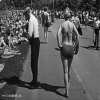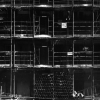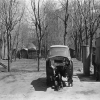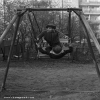

Alexander Slyusarev
|
Alexander Slyusarev (in another writing San Sanych Slyusarev), (October 9, 1944, Moscow - April 23, 2010, Moscow). Alexander Slyusarev began photographing in 1958, when his father gave him a range finding camera "Yunost". His first encounter with photography was the "Soviet Photo" magazine and the American photo exhibition "The human race" in 1959. Slyusarev did not get to see it, escaping, as he said, a too strong impression of the spectacular, but bad show- still it had a great influence on him: in 1962 and 1964 he participated in the exhibitions, "Our Youth", organized likewise to it by the Committee of youth organizations. In the CYO young Slyusarev, still in a school uniform, met with photographers, who already worked in the offices, such as Ahlomov, Aleshkin, Reznikov and Zhibin. There he joined the "fraction of the formalists," who determined the "formalism" as a rule of form rather than literary content. In 1979, A.A. Slyusarev participated in the Baltic photo festival in Dzinterzdeme ("Amber Land"), after which his name became a symbol of the "Moscow" school of art photography. Slyusarev says that at the exhibition in Shiauliai he introduced himself as one of the founders of the Moscow school of photography, and in the next town he was met as the "Father of Russian photography." In photographic circles, and now fans, call him San Sanych, and his signature is often an anagram of SSS. Alexander Slyusarev is called the photographer of shadows, glares and reflections. For the photographer, they are more important than the actual surface of the objects. Slyusarev says that it is quite natural, because in fact the subject is diverse: it is as many as you want to see it yourself. In particular, the shadow and highlight possess the same initial value of the visual, which possesses the object itself. Slyusarev believes that the most important story, appearing in his works is urban space. He coined the term "flat landscape". He formulated it, giving the name of a particular shot, but this type of picture was in the earlier works: a landscape, without a linear, diagonal perspective. Alexander’s pictures expand the genre of still life. The object in them, as in still-life, is symbolic. With one difference, however, that the meaning of the symbol remains unclear. And it is not a "forgotten" meaning of old still life, and not a commercial meaning of advertisment still life, but a not yet opened to us meaning of the real life environment. According to Slyusarev, he looks for typical things, objects, situations - what one sees - and tries to apply them. Alexander Rappaport writes that the secret appeal of these images are not only technical perfection - the nuances and contrasts of black and white, the drawing of the most delicate texture, contrast of linear sharpness and textured softnessness - but also features of the photographic transfer of time, which is given by Slyusarev in a very difficult and rare form of monumental unity and immediate. The subject of the situation, the camera angles are often just as immediate as is the very time of exposure - it's just a moment in the flow of time. But the composition built on a balanced combination of horizontals and verticals – is monumental as something eternal and unchanging. The contrast of these temporary forms give our most ordinary fragments of objective world significance to which we are not accustomed to. The author defines the photography, which he is engaged in, as analytic, that is, to him information about a specific moment is not important, important is information about the state of this moment.  go back to "Photographers" go back to "Photographers" |






